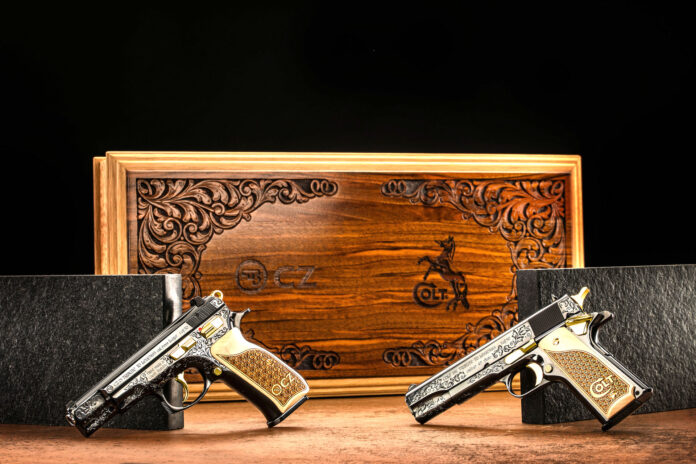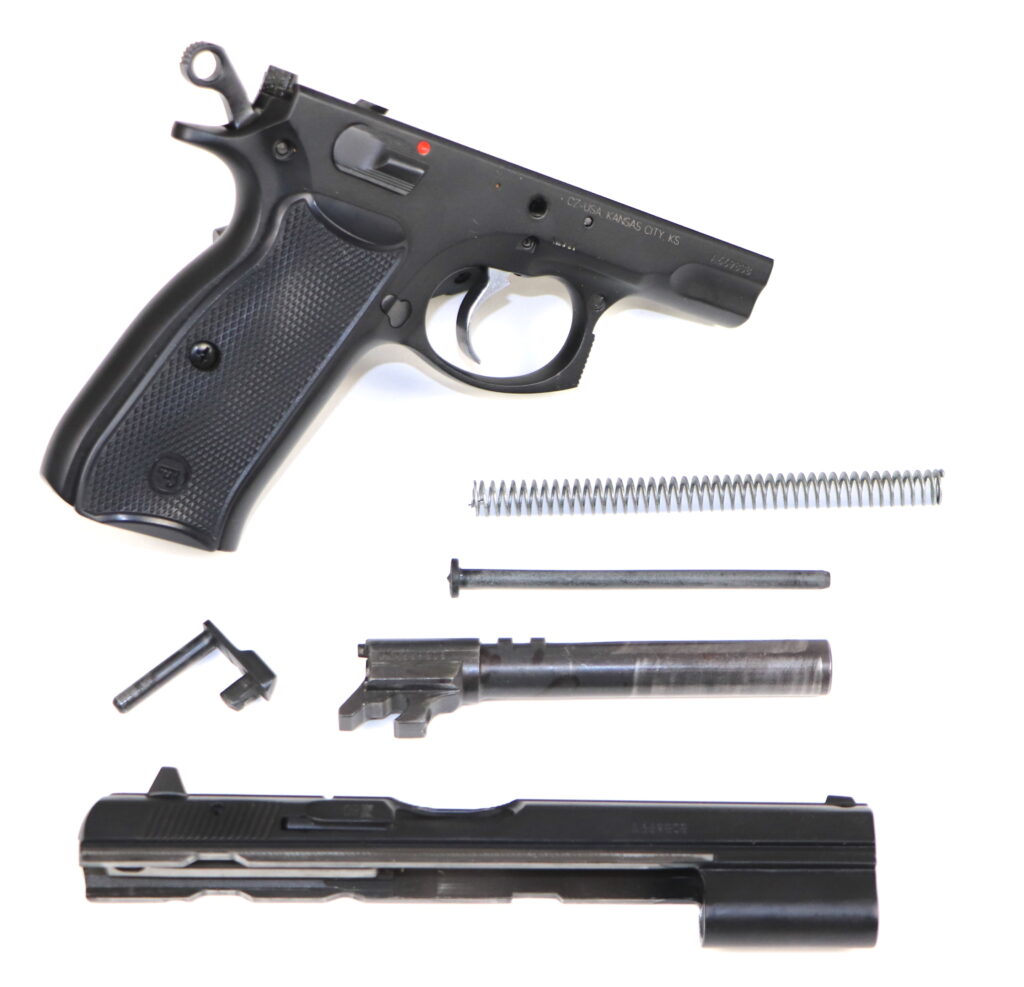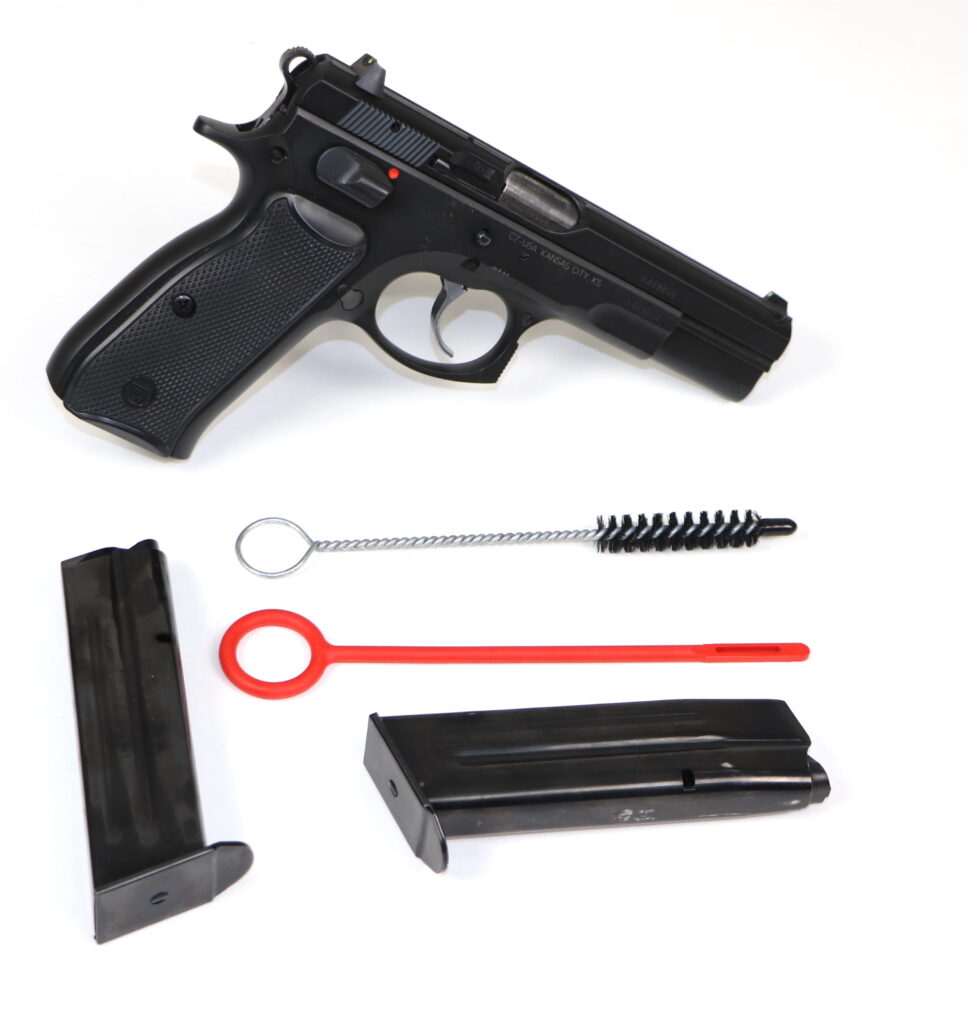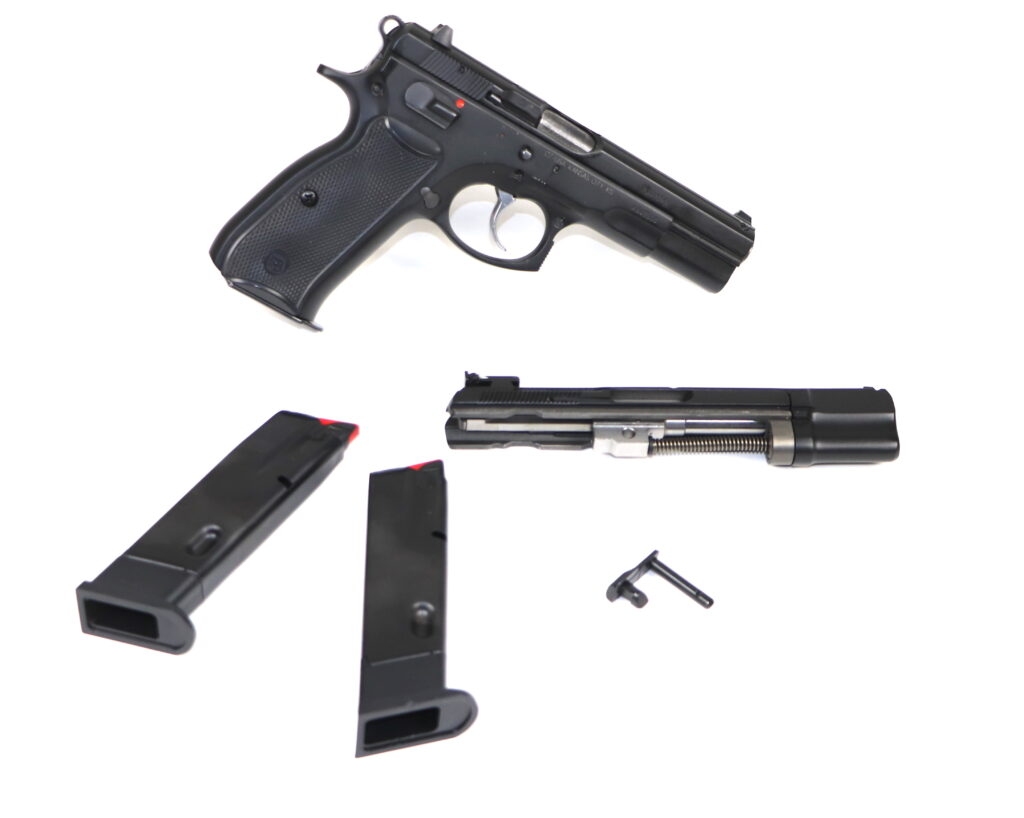
BY STEVE COMUS
Sometimes a person just wants a no-frills, basic handgun that works both easily and intuitively while not breaking the bank in the process. Think CZ 75.
The CZ 75 pistol was in the news again recently when 50 sets of hand-engraved Colt 1911 and CZ 75 pistols were auctioned off in a Limited Edition Tribute to Legends, which commemorated the merger of Colt and CZ into one holding company in May 2021.
Ironically, the 1911 and CZ 75 were related all along because the CZ 75 is perhaps the most highly evolved incarnation of John Browning’s P35, which, in itself, evolved from the 1911. More about that later in this article.
The full-size CZ 75 9mmP pistol is considered by many as being the most advanced of the traditional hammer-fired, steel frame holster semi-auto handguns.

It survives in the market despite the onslaught of striker-fired polymer-frame pistols (think Glock) that are generally available at a lower price point than their steel-frame counterparts. Both kinds of pistols are reliable and durable.
To understand the CZ 75 and how it fits into the overall picture, it is handy to understand how it came to be and what preceded it.
The CZ 75 was designed by Josef and Frantisek Koucky in 1975 and introduced in 1976 by Česká zbrojovka a.s. Uherský Brod (CZUB), in what is now the Czech Republic. There have been well over 1 million of this model made.
Essentially, the CZ 75 evolved from the P-35, better known as the Browning Hi-Power. CZ merely took the basic Browning design and enhanced it, changing a few things here and there, but basically retaining the original concept.
Traditional semi-auto pistols date back to 1891 (less than a decade after the invention of smokeless gunpowder) with the design of an unsuccessful hammer-fired pistol. The first successful semi-auto pistol was the Borchardt C-93, which was designed in 1893 and made available in 1894. The Borchardt was the inspiration for the P-08 Luger – both of which were striker-fired (the same system now used in the Glock and many other polymer-frame pistols).
Within the next two decades, there were many hammer-fired semi-auto pistols introduced, including the ubiquitous Model 1911. All these early pistols featured steel frames and wood grips.
John Browning, who brought us the 1911 among his many designs, died during the development of what became the P-35 in military parlance, or the Browning Hi-Power in civilian garb. Three years after that introduction, Walther came out with the P-38, the first to feature a de-cocking mechanism combined with double action/single-action trigger – both of which are available in the CZ 75BD.
In the initial design of the P-35, Browning changed several things, including the way the recoil spring is housed and how the barrel is held in place as the slide moves backward and then returns forward during cycling.
Bluntly, what this means is that Browning himself obsoleted a couple of features of the 1911, although such a statement likely can be considered blasphemous among 1911 afficionados.
Although there are several smaller sub-models, the full-size CZ 75B or BD (D is for de-cock) remains the flagship pistol in the CZ lineup, which also includes a host of polymer frame pistols.
Like its predecessor P-35, the CZ 75 operates on a short recoil, locked breech system that features a linkless cam locking system (as opposed to the linked-cam system in the 1911). This means that the barrel and slide are held together during the initial recoil, but that after a short distance, the back of the barrel is tilted downward as the slide continues its rearward movement.
Similar lockup systems are used in many of the modern polymer-frame pistols, as well.
The full-size CZ 75 is considered to be a “holster pistol” in that it is intended to be carried in a holster rather than, say, a pocket.
Dimensionally, the full-size CZ 75 weighs 35.2 ounces, is 8.1 inches long and has a 4.6-inch cold hammer forged barrel.
It is 1.4 inches wide and 5.4 inches high. Magazine capacity ranges from 10 to 26 rounds, with a 16-round magazine common where limited magazine capacity is not required.
Grips are plastic, frame is steel, and sights are fixed three-dot (two on the rear sight and one on the front sight). The CZ 75B has a manual safety with safety stop on the hammer and a firing pin block. Although the CZ 75 was available in .40 S&W until 2018, it now is available only in its original 9mmP (Parabellum/Luger 9x19mm) chambering.
What has kept the CZ 75 at the forefront, even when the market saw a tidal wave of polymer frame pistols priced more affordably (it is more expensive to make steel frame pistols than polymer frame pistols) is that the CZ 75 looks and feels like a “real” gun, its size and shape make it easy for a wide range of hand sizes to use effectively and it is about as durable as a semi-auto can be. It just works well for all kinds of folks.
Reliability is a hallmark of the CZ 75. When I was writing the Gun Digest Book of 9mm Handguns in the long ago, I shot hundreds of rounds of every kind of 9mm ammo available at the time through the CZ 75.

It functioned flawlessly with every kind of ammo/bullet combination and accuracy hovered around the 3-inch mark at 25 yards with all of the ammo types (quite nice for a handgun designed for general military, police, defense and recreation).
However, like any semi-auto, it is ammo sensitive. It takes a certain amount of energy from the fired round to cycle the pistol for the next round. This means that if there is a misfire, or if the ammo is not strong enough, the pistol will fail to cycle and fire the next round. This is not an issue with revolvers, for example, because the shooter’s energy is used to cycle them.
The handle on the CZ 75 is both big and wide enough so that my oversized hand fits it very well. Yet, others who have smaller hands also are able to shoot it well. That’s nice.
But perhaps the most memorable thing about shooting the CZ 75 is that it is intuitive to use. Everything is straight-forward, where it should be and works as it should work.
A favorite CZ 75 for me is chambered for the .40 S&W cartridge. It is one heck of a nice handgun, so when I acquired it, I also got the .22 long rifle conversion kit, which is a different barrel/slide combo along with a different magazine and slide release mechanism.
As is common among handgun designs with a military history, the CZ 75 can be disassembled and reassembled quickly and easily without tools for cleaning and routine maintenance.
Above all, the CZ 75 remains a valid handgun and is a model that deserves consideration. It is a moderately priced, top performer that can last several lifetimes, even under moderate to heavy use.



